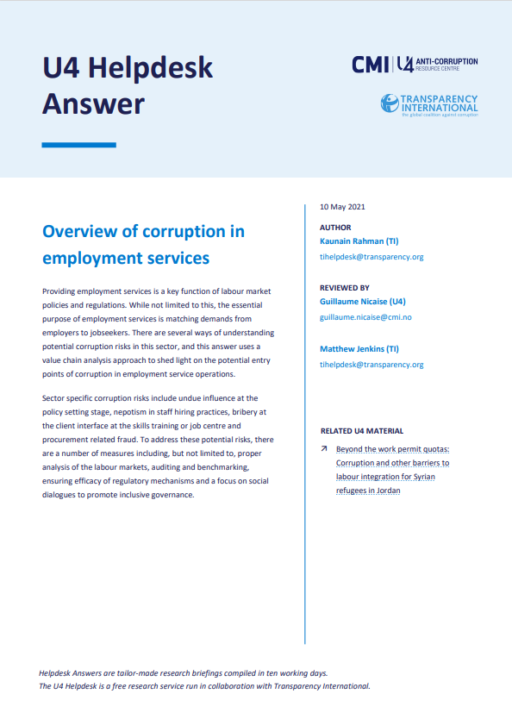
This Anti-Corruption Helpdesk brief was produced in response to a query from a U4 Partner Agency. The U4 Helpdesk is operated by Transparency International in collaboration with the U4 Anti-Corruption Resource Centre based at the Chr. Michelsen Institute.
Query
What are the main risks for corrupt practices in labour market policy, social dialogue and employment services? How can these risks be mitigated?
Summary
Providing employment services is a key function of labour market policies and regulations. While not limited to this, the essential purpose of employment services is matching demands from employers to jobseekers. There are several ways of understanding potential corruption risks in this sector, and this answer uses a value chain analysis approach to shed light on the potential entry points of corruption in employment service operations.
Sector specific corruption risks include undue influence at the policy setting stage, nepotism in staff hiring practices, bribery at the client interface at the skills training or job centre and procurement related fraud. To address these potential risks, there are a number of measures including, but not limited to, proper analysis of the labour markets, auditing and benchmarking, ensuring efficacy of regulatory mechanisms and a focus on social dialogues to promote inclusive governance.
Contents
- Background
- Understanding corruption in the value chain
- Sector specific corruption risks
- Potential mitigation measures
- References
Main points
- Corruption risks faced by employment agencies are closely related to the background conditions in which they operate.
- Measures aimed at reducing long-term unemployment can be rendered ineffective by weak administrative capacity and poor governance, both of which are hallmarks of economies with a high incidence of corruption.
- Specific corruption risks may occur at different points of the employment services value chain. For example, undue influence in policy setting, nepotism in hiring and bribery at the client interface.
- Potential mitigation measures include thorough contextual analysis, social dialogue, due diligence and performance management.
Caveat
The extent and forms of corruption that can affect the work of employment services depend on a range of variables, including country context, institutional structure and working practices.
Identifying an exhaustive list of corruption risks that could occur in the various settings where employment services are carried out is thus not only beyond the scope of this Helpdesk Answer but also relatively futile. Instead, this paper provides a framework to understand the various corruption risks that employment services in particular and labour market policies in general may be exposed to and showcases several mitigation measures that could be applied to reduce vulnerabilities.
Authors
Kaunain Rahman (TI), [email protected]
Reviewers
Guillaume Nicaise (U4), [email protected]
Matthew Jenkins (TI), [email protected]
Date
05/07/2021

